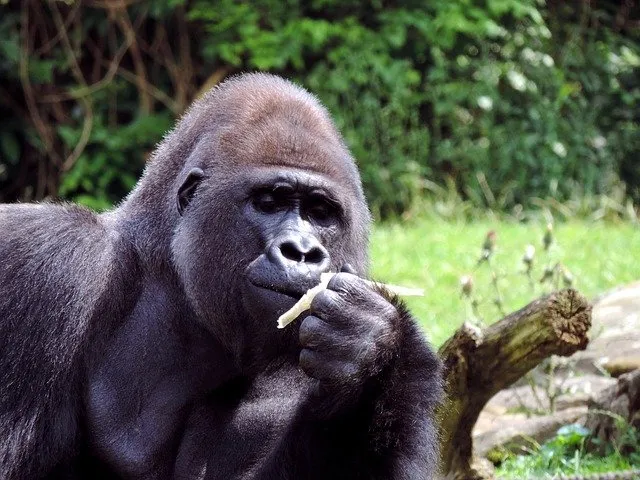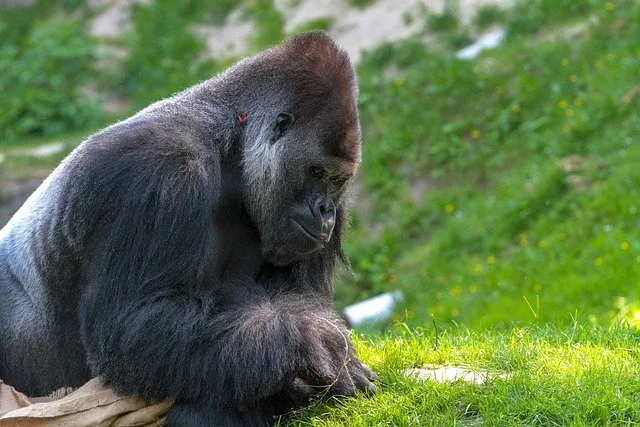As an Amazon Associate I earn from qualifying purchases.
An enigmatic question lingers in the heart of the lush and mysterious African rainforests: “What do silverback gorillas eat?” These majestic creatures, known for their awe-inspiring presence and familial bonds, have captivated the world’s attention. Their diets, as we are about to explore in this blog, hold the key to their strength and vitality.
Join us on a captivating journey into the dietary world of silverback gorillas as we uncover the secrets behind their immense power, favorite foods, and how their nutritional choices shape their existence in the wild. Prepare to be enlightened and amazed as we unravel the culinary wonders of these iconic primates.
What Do Silverback Gorillas Eat?
Silverback gorillas mostly feed on plant-based foods, making them herbivores primarily. Their diet must consist of a wide range of plants, leaves, and fruits, along with necessary supplements to guarantee adequate nutrition for their survival and growth.
1. Leaves:
Leaves constitute a substantial portion of a silverback gorilla’s diet, encompassing a diverse selection of foliage such as young leaves, shoots, and stems. Among their preferred leafy greens are bamboo leaves, which offer a fiber-rich, hydrating source of nourishment. Wild celery leaves also rank high on their menu, delivering crucial vitamins and minerals. Surprisingly, silverbacks are undeterred by stinging nettles, embracing them for their exceptional nutritional value.
2. Fruits:
Fruits are vital in a silverback gorilla’s diet, supplying essential sugars and vitamins. Among the fruits relished by silverbacks are figs, prized for their sweet taste and rich nutritional content, providing a valuable energy source. Bananas, with their effortless consumption and high potassium content, rank as a favorite among these gorillas. Additionally, various types of berries make seasonal appearances on their menu, offering antioxidants and extra vitamins to support their well-being.
3. Bark and Shoots:
Silverbacks supplement their diet by consuming tree bark and young shoots; although these may not be as nutritionally dense as other food sources, they still offer essential nutrients. Tree bark, which gorillas frequently strip from trees to access the inner layers, can contain vital minerals that contributing to their overall health. Young shoots, on the other hand, are easier to digest and serve as a valuable source of dietary fiber, adding a beneficial dimension to their nutritional intake.
4. Insects:
While insects are not a primary food source for silverback gorillas, they make occasional forays into entomophagy, adding a protein boost to their diet. Among their insect choices are ants and termites, which gorillas may deftly extract from nests using sticks or fingers, showcasing their adaptability in acquiring additional nutrients when needed.
5. Supplements:
Silverback gorillas may also consume other materials like soil and clay to ensure they receive all the necessary nutrients. This behavior, known as geophagy, helps them obtain minerals like potassium and sodium.
How Do Silverback Gorillas Forage For Food?
Silverback gorillas are skilled foragers, and their foraging behavior is an intricate process that involves various techniques and strategies. Here’s a detailed look at how silverback gorillas forage for food:
1. Introduction to Silverback Gorilla Foraging
Silverback gorillas, the iconic and influential primates of the African rainforests, have evolved intricate foraging strategies that allow them to thrive in their natural habitats. Their foraging behavior is vital to their daily lives, influencing their dietary choices, group dynamics, and overall survival. This article will delve into how silverback gorillas forage for food, shedding light on their techniques, social interactions, and adaptability.
2. Group Dynamics and Foraging
Silverback gorillas are highly social creatures, living in troops led by a dominant adult male, the silverback. Their group structure plays a significant role in foraging. Group members cooperate to find and exploit food resources efficiently. They often share information about the food location, and the leader’s cues guide the troop to the best feeding spots. Social foraging enhances their chances of locating food and strengthens social bonds within the group.
3. Feeding Techniques and Diet
Gorillas employ various feeding techniques, ranging from browsing leaves and plucking fruit to ground feeding on plants and tubers. They are selective eaters, choosing the ripest and most nutritious parts of plants and fruits. When fruits are in season, they play a pivotal role in the gorilla diet, and gorillas may use their strength to access fruit-laden branches. Additionally, they are known for their occasional tool use, using sticks or branches to extract insects like ants and termites from nests.
4. Communication and Adaptation
Communication is integral to gorilla foraging. They use vocalizations, gestures, and body language to convey information about food sources and maintain social cohesion. Gorillas are adaptable foragers, adjusting their diet based on seasonal variations in food availability. During the wet season, when fruits are abundant, they may shift their diet towards a higher fruit intake, while in the dry season, they rely more on leaves and other vegetation. This adaptability helps them ensure a stable food supply.
5. Conservation Significance
Understanding silverback gorilla foraging behavior is crucial for appreciating their remarkable adaptations and conservation efforts. These primates are keystone species in their ecosystems, influencing plant dynamics, seed dispersal, and overall forest health. Efforts to protect their habitats and the biodiversity within them are essential for the gorillas and the broader ecosystem they inhabit. In preserving silverback gorillas and their foraging habitats, we contribute to the well-being of countless other species and the health of our planet’s rainforests.
How Can Silverback Gorillas Impact Our Ecosystem?
Silverback gorillas, as keystone species in their ecosystems, play a crucial role in maintaining the balance and health of the environment in several ways:
1. Seed Dispersal:
Gorillas are frugivores, meaning they consume fruits as a significant part of their diet. As they move through the forest, they ingest fruits and excrete the seeds at different locations. This seed dispersal contributes to various plant species’ growth, promoting biodiversity. Some seeds even rely on gorilla digestive processes to break down their tough outer shells, enhancing their chances of germination.
2. Plant Pruning:
Gorillas feed on leaves, stems, and shoots, which helps control the growth of certain plant species. Doing so prevents the overgrowth of specific plants that could otherwise smother other vegetation, maintaining a diverse plant ecosystem.
3. Habitat Modification:
Gorillas often construct nests for resting at night. These nests are typically built in trees; completing them can involve breaking and bending branches. This activity can create small clearings in the forest canopy, allowing sunlight to reach the forest floor. These clearings can stimulate the growth of certain plant species that require sunlight, further diversifying the forest.
4. Predator-Prey Dynamics:
The presence of large herbivores like gorillas can influence the behavior of predators in their ecosystem. Predators often avoid encounters with gorillas due to the risk of injury. As a result, the presence of gorillas can indirectly protect smaller herbivores by deterring their common predators.
5. Tourism and Conservation:
Silverback gorillas are charismatic megafauna that draw tourists and researchers to their habitats. This, in turn, can contribute to the local and national economies through ecotourism. Revenue generated from gorilla tourism can fund conservation efforts and support local communities, providing incentives to protect gorilla habitats and biodiversity.
6. Carbon Sequestration:
Forests, including those inhabited by gorillas, are vital for carbon sequestration. Gorillas help maintain the health of these forests, ensuring they continue to absorb and store carbon dioxide, mitigating climate change impacts.
7. Indicator Species:
The well-being of silverback gorilla populations can serve as an indicator of the overall health of their habitat. A decline in gorilla populations often signals underlying environmental issues, such as habitat loss or degradation, making them a barometer for the broader ecosystem’s health.
Final Words
In summary, understanding ‘what do silverback gorillas eat?’ reveals their complex foraging behavior and ecological significance. Their dietary choices and adaptability impact their survival and the health of their rainforest habitats. Protecting these habitats and ensuring food source sustainability is crucial for preserving silverback gorillas and their diverse ecosystems.
You can also read:
1.What Do Painted Lady Butterflies Eat? From Caterpillar to Butterfly
2.A Lovebird’s Culinary Delight: What Do Lovebirds Eat?
3.What Do House Wrens Eat? Insectivores of the Garden
4.What Do Hippopotamuses Eat? Dining with Giants
Amazon and the Amazon logo are trademarks of Amazon.com, Inc, or its affiliates.



